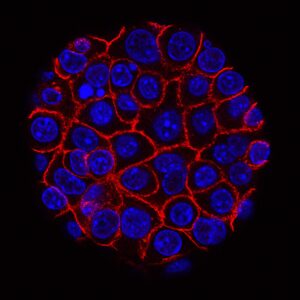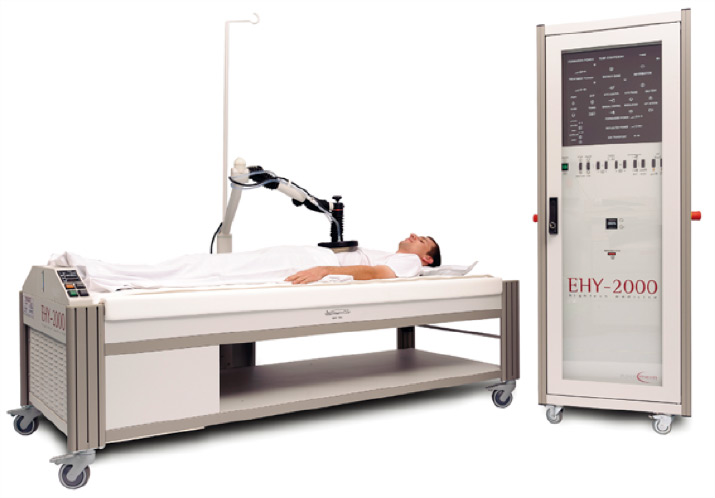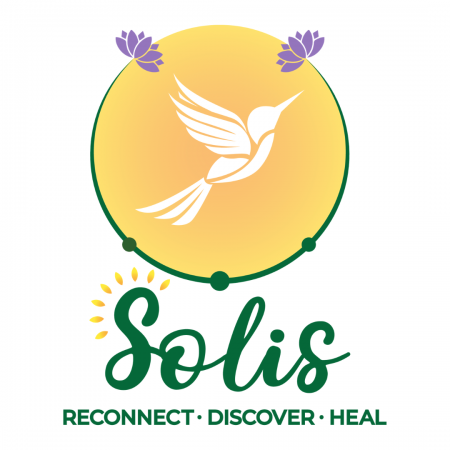Okay, so it’s not really like a campfire or hot coals, but building on my post last week about infrared saunas, I am continuing today with another heat-centred therapy: hyperthermia. The opposite of hypothermia (which most people are familiar with and often confuse this with), this therapy uses heat to accomplish a number of positive effects when it comes to cancer. There are two ways that it is used, as either a complementary therapy alongside conventional interventions as a way to boost their efficacy, or as a stand-alone alternative therapy as part of an all-natural approach in place of conventional treatments for those taking that route. We’ll explore the science behind this therapy and both options in order to help you determine if hyperthermia is a fit for you and your protocol.
 How and Why Does Hyperthermia Work?
How and Why Does Hyperthermia Work?
The science behind why hyperthermia is proving to be effective against cancer comes down to the environment where cancer cells thrive and how it differs from the environment of healthy cells. In a tumour, the pH is low compared to a healthy area of the body and the pO2 (partial pressure of oxygen, i.e. the amount of oxygen in the blood) is also low, meaning that the environment in and around a tumour is both acidic and low in oxygen due to low blood flow [1]. Oxygen is essential for cell functions, and when there isn’t enough of it, cells start to malfunction, contributing to the development and persistence of cancer. Similarly, when an environment is too acidic, it can also drive cancer growth and metastasis; an acidic environment has been found to have a number of effects on cancer, including blocking T-cell activation (T-cells are immune cells that play a vital role in your immune response) [2] and helping tumour cells make proteins that turn on genes which make them more aggressive and prone to invasion [3].
Temperatures of between 40 and 45 degrees Celsius are cytotoxic for cells in an environment that has a low pH and a low pO2 because they are sensitized to heat by these conditions. In this way, hyperthermia is a targeted treatment, affecting cancer cells while leaving normal tissue unharmed. This is a vital difference between therapies such as chemo and radiation that go after everything in their path, healthy or not, and targeted therapies are where more and more research is being focused these days.
These high temperatures achieve a number of effects. First, the heat weakens cancer cell walls, making them more permeable and allowing cytotoxic agents (such as chemo, radiation, and natural anticancer substances) to more easily enter the cell and inflict more damage [4]. This weakening can also result in the death of young or otherwise feeble cancer cells as well as nearby blood vessels that are feeding the tumour [4, 5]. Second, many drugs are potentiated (made more powerful) by heat, making them more effective against cancer cells [4]. And third, hyperthermia can help to counteract drug resistance in cancer cells by increasing their drug uptake, enhancing DNA damage in those cells, and causing higher concentrations of cytotoxic agents to reach the tumour due to improved blood flow [4]. In all of these ways, hyperthermia can be a powerful complementary therapy to use during active treatment, and it can also have positive effects for those taking an all-natural approach by making cancer cells more susceptible to natural cytotoxins one might be taking (vitamin C IVs for example) and weakening and/or killing cancer cells.
 Are there any side effects to know about?
Are there any side effects to know about?
Side effects depend on the method of delivery and the area of the body being treated, but most side effects of hyperthermia are mild and don’t last long. There are, however, a few that can be more serious, and so they are good to know about and discuss with your healthcare team to determine if they are a possibility for the type and location of hyperthermia you plan on receiving.
Local hyperthermia can cause pain at the site, infection, bleeding, blood clots, swelling, burns, blistering, and damage to the skin, muscles, and nerves near the treated area [5]. This is all sounds very scary, but I personally only ever experienced some aching pain at the treatment site and only for the duration of the treatment (about an hour). It was totally manageable and there was also a little button I could push and they would come right away and adjust the heat if it got too painful, but it never did for me.
With whole-body hyperthermia, it’s like a fever is being induced because the temperature of your whole body is being raised. It can therefore cause flu-like symptoms such as nausea, vomiting, and diarrhea [5]. There are a few more serious but very rare side effects such as problems with the heart, blood vessels, and other major organs, but “experience, improved technology, and better skills in using hyperthermia treatment have led to fewer side effects. In most cases, the problems that people have with hyperthermia are not serious” [5].
 How Does Hyperthermia as a Complementary Therapy Differ from Hyperthermia as an Alternative Treatment?
How Does Hyperthermia as a Complementary Therapy Differ from Hyperthermia as an Alternative Treatment?
As a complementary therapy, hyperthermia is timed with your conventional treatments so that you receive them both in close proximity. This allows for the conventional treatments to be potentiated by hyperthermia and for the two therapies to work synergistically against your cancer cells. For example, because I am HER2+, I received Herceptin once every three weeks for a year. I would go to the chemo suite to receive Herceptin, and then I would travel to Kitchener right afterwards to receive a hyperthermia treatment. Then, I would return to Kitchener the next day to receive another treatment and a high dose vitamin C IV. As a stand-alone alternative treatment, you will receive doses a few times a week for a set number of consecutive weeks, versus only receiving it when you also receive a conventional treatment.
How is Hyperthermia Delivered?
There are a few types of delivery methods when looking at hyperthermia. The two main ways are external and internal hyperthermia. Internal hyperthermia can be further divided into two types: one, a chemo agent or other drug is heated and then circulated through the abdominal cavity (this is often used when cancer has spread to the abdominal wall); and two, a microwave or radiofrequency antenna is implanted to deliver local thermal doses [6]. External hyperthermia makes use of a hyperthermia machine to deliver doses either to your entire body (whole-body hyperthermia) or localized thermal doses to an area where a tumour is or was (locoregional hyperthermia) [6], and this is the type that I received. Currently, whole-body external hyperthermia is not available anywhere close to Toronto, and even locoregional external hyperthermia is hard to find. Fortunately, there are two clinics that I know of in Southern Ontario that offer it; I have listed them both below, but there could be more that I’m just unaware of.

External hyperthermia (image from: https://healthsourceimc.com/cancer-care/treatments-and-integrative-therapies/hyperthermia/)
I went to Health Source in Kitchener to receive my treatments and, as I said above, they were timed with my Herceptin infusions. It was a rather lovely experience, especially on cold winter days! I would arrive and put on a gown exactly like those you wear at the hospital. I would then lie down on what felt like a waterbed that had a conduction plate under it. An arm, kind of like the tray on an arm at the dentist’s office, extended over the bed, and on the end was the hyperthermia probe, as they called it. It was a circular plate with a water-filled cushion attached. Cool water was constantly circulated in and out of the cushion in order to help keep my skin cool and reduce any discomfort from the high heat of the therapy while not interfering with the heat being delivered deeper into my body. There was a large probe that delivered heat to a wider area, and then there was also a smaller probe that delivered more targeted, more powerful heat to a concentrated area; right where my tumour had been in both cases. The first day, we would use the larger probe, and the second day, we would use the smaller probe; this was in order reap the benefits of both the larger area offered by the big probe and the stronger heat offered by the small probe.
And that was it! They would place the probe on the area where my tumour had been, and then I would lie on the warm bed and listen to relaxing music for an hour. Sometimes Jesse would come and read to me, and when he couldn’t, I would nap or read or meditate. It was really quite nice 🙂 In terms of side effects, the only thing I noticed was some aching in the area when we used the smaller probe, due to the increased strength and concentration of the heat, but it was entirely bearable. As I understand it, some people experience more of this aching than others, so they usually start you at lower temperatures and work their way up until you reach either full strength or the highest that you can tolerate comfortably. So not to worry, if you are concerned about this aspect of it, you will not be forced to endure something you can’t handle. As Dr. Reid always said to me, this isn’t a “push through and stick it out scenario”; if it’s uncomfortable, let them know and there is no issue with reducing the heat.
Hyperthermia not only had positive physical effects for me, but incorporating this therapy also helped quell my anxiety and fear. Because I chose to only do one round of chemo and refuse radiation, I was putting a lot on my use of Herceptin and Tamoxifen. Pairing them with hyperthermia helped me to feel confident that I was making these drugs as effective as they could possibly be and drawing them in higher concentrations to the former home my tumour made, while also weakening and killing any cancer cells that might still be in that area.
There aren’t a lot of machines in North America, but if you are located in the GTA and would like to learn more about hyperthermia and whether it’s a good option for you, I highly recommend seeing Dr. Michael Reid at HealthSource Integrative Medical Centre in Kitchener. There is also a machine at the Marsden Centre in Vaughan, though I have no personal experience with this clinic. If you are not located in the GTA, do a Google search for “hyperthermia cancer treatment” and your location to see if there is a clinic with a machine in your area.
And if you have any questions about my own experience with hyperthermia, leave a comment below or use the Contact Me page and I would be happy to answer them!
Happy Healing ❤️
References
- Partial Pressure of Oxygen (PO2) – https://www.ncbi.nlm.nih.gov/books/NBK493219/
- Neutralization of Tumor Acidity Improves Antitumor Responses to Immunotherapy – http://cancerres.aacrjournals.org/content/canres/76/6/1381.full.pdf
- Acidic environment triggers genes that help cancer cells metastasize – https://medicalxpress.com/news/2019-03-acidic-environment-triggers-genes-cancer.html
- Heating the patient: a promising approach? – https://www.annalsofoncology.org/article/S0923-7534(19)63846-9/fulltext
- Hyperthermia to Treat Cancer – https://www.cancer.org/treatment/treatments-and-side-effects/treatment-types/hyperthermia.html
- Locoregional Hyperthermia – https://www.ncbi.nlm.nih.gov/books/NBK6347/




Thank you very much for the time you have spent on researching all of this valuable information! I am finding this very helpful and feeling better about the journey I will be undertaking this coming year. I appreciate all you have been doing with your website!
I’m so glad you’re finding it helpful Hali! And I’m also very happy that you are feeling better about your journey. Positivity really does so much for our mental and emotional state, and while we will have our down moments, it’s important to find our way back to the light when and however we can. You’ve got this!